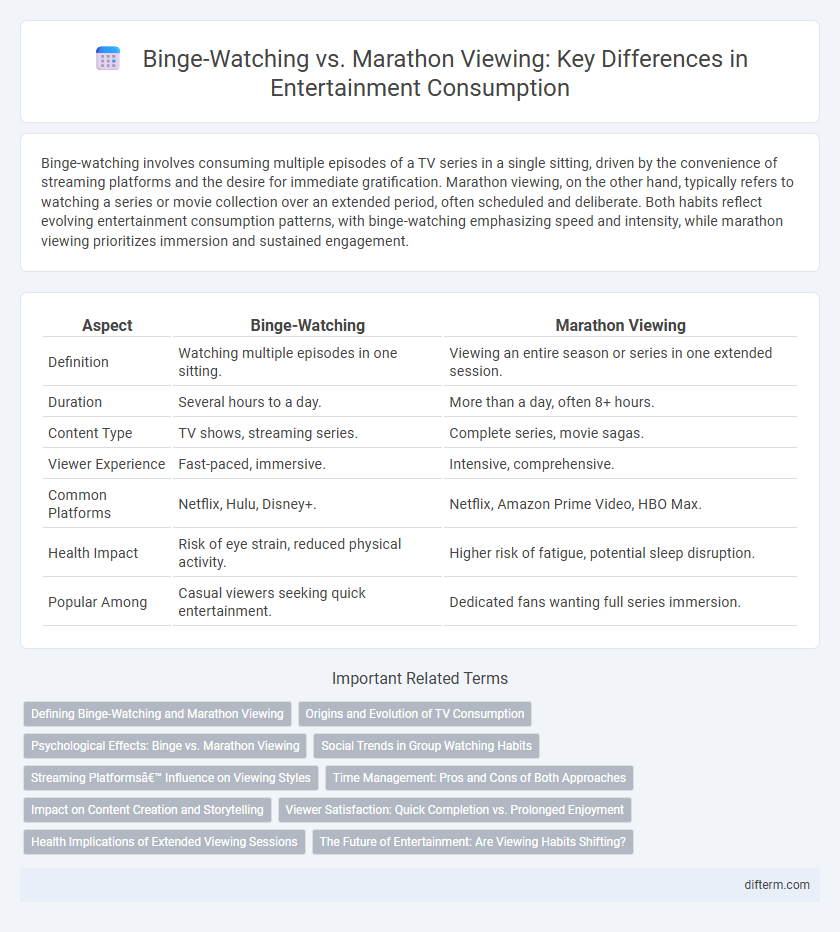Binge-watching involves consuming multiple episodes of a TV series in a single sitting, driven by the convenience of streaming platforms and the desire for immediate gratification. Marathon viewing, on the other hand, typically refers to watching a series or movie collection over an extended period, often scheduled and deliberate. Both habits reflect evolving entertainment consumption patterns, with binge-watching emphasizing speed and intensity, while marathon viewing prioritizes immersion and sustained engagement.
Table of Comparison
| Aspect | Binge-Watching | Marathon Viewing |
|---|---|---|
| Definition | Watching multiple episodes in one sitting. | Viewing an entire season or series in one extended session. |
| Duration | Several hours to a day. | More than a day, often 8+ hours. |
| Content Type | TV shows, streaming series. | Complete series, movie sagas. |
| Viewer Experience | Fast-paced, immersive. | Intensive, comprehensive. |
| Common Platforms | Netflix, Hulu, Disney+. | Netflix, Amazon Prime Video, HBO Max. |
| Health Impact | Risk of eye strain, reduced physical activity. | Higher risk of fatigue, potential sleep disruption. |
| Popular Among | Casual viewers seeking quick entertainment. | Dedicated fans wanting full series immersion. |
Defining Binge-Watching and Marathon Viewing
Binge-watching refers to consuming multiple episodes of a TV series in a single sitting, often driven by streaming platforms releasing entire seasons at once. Marathon viewing involves watching an extended sequence of episodes or movies, sometimes spread over several sessions but linked by a common theme or series. Both practices highlight evolving consumption patterns in digital entertainment landscapes.
Origins and Evolution of TV Consumption
Binge-watching originated from the rise of streaming platforms like Netflix in the early 2010s, revolutionizing TV consumption by enabling viewers to watch multiple episodes consecutively. Marathon viewing, a practice dating back to the 20th century, involved scheduled, extended TV sessions often tied to special events or seasonal broadcasts. The evolution of on-demand technology shifted audience behavior from traditional marathon sessions to personalized binge-watching experiences, significantly impacting content production and release strategies.
Psychological Effects: Binge vs. Marathon Viewing
Binge-watching often triggers instant gratification and dopamine release, leading to heightened excitement but potential increased anxiety and sleep disruption. Marathon viewing, characterized by intentional, spaced-out sessions, tends to promote deeper narrative engagement and better emotional processing. Both behaviors influence mental health differently, with binge patterns linked to impulsivity and marathon viewing supporting sustained attention and relaxation.
Social Trends in Group Watching Habits
Binge-watching dominates social trends as viewers increasingly prefer consuming entire series in one sitting, creating shared cultural moments and online discussions. Marathon viewing events, often organized by fan groups or streaming platforms, foster community engagement through scheduled group sessions, enhancing collective excitement. Both habits reflect shifting entertainment consumption patterns that emphasize social interaction and shared experiences.
Streaming Platforms’ Influence on Viewing Styles
Streaming platforms have revolutionized viewing styles by enabling binge-watching, where audiences consume multiple episodes in a single sitting, contrasting with traditional marathon viewing that typically occurs during special events or series finales. Algorithms and personalized recommendations on platforms like Netflix and Hulu encourage continuous watching, increasing viewer engagement and session duration. This shift has transformed entertainment consumption, influencing content production to prioritize serialized narratives and cliffhangers that sustain prolonged viewer attention.
Time Management: Pros and Cons of Both Approaches
Binge-watching allows viewers to consume large amounts of content rapidly, offering immediate gratification but often leading to poor time management and fatigue. Marathon viewing involves planned, extended sessions that can enhance narrative immersion but may disrupt daily routines if not moderated. Balancing both approaches requires awareness of one's schedule and self-discipline to avoid negative impacts on productivity and health.
Impact on Content Creation and Storytelling
Binge-watching drives content creators to develop serialized narratives with cliffhangers and interconnected episodes, enhancing viewer engagement and emotional investment. Marathon viewing encourages pacing adjustments and character development depth to sustain audience interest over extended sessions. Both consumption modes push storytellers to innovate formats, balancing episodic satisfaction with overarching plot coherence.
Viewer Satisfaction: Quick Completion vs. Prolonged Enjoyment
Binge-watching often boosts viewer satisfaction by delivering quick completion and instant gratification through rapid episode consumption. Marathon viewing enhances prolonged enjoyment by allowing audiences to savor narrative depth and character development over extended periods. Each approach caters to different preferences, balancing fast-paced excitement with immersive storytelling experiences.
Health Implications of Extended Viewing Sessions
Binge-watching and marathon viewing often lead to prolonged sedentary behavior, increasing risks for obesity, cardiovascular issues, and eye strain. Extended screen time disrupts sleep patterns due to blue light exposure, impairing cognitive function and overall wellbeing. Incorporating breaks and physical activity during viewing sessions helps mitigate adverse health effects while maintaining entertainment enjoyment.
The Future of Entertainment: Are Viewing Habits Shifting?
Binge-watching dominates current entertainment consumption, driven by streaming platforms releasing entire seasons at once, allowing viewers to engage deeply with storylines. Marathon viewing, characterized by extended, intentional consumption of multiple episodes or films over a set period, is evolving with interactive and immersive technologies enhancing the experience. Shifts in viewing habits reflect a growing demand for flexibility, personalized content delivery, and integration of social media, signaling a transformative future for entertainment engagement.
Binge-watching vs marathon viewing Infographic

 difterm.com
difterm.com